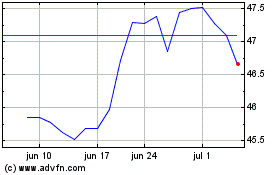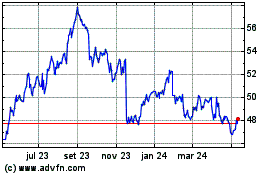New Cisco Study Finds Only 9% of Canadian Companies Surveyed are Ready to Defend Against Cybersecurity Threats
21 Março 2023 - 8:00AM

A mere 9% of organizations in Canada have the ‘Mature’ level of
readiness needed to be resilient against today’s modern
cybersecurity risks, according to Cisco’s NASDAQ: CSCO first-ever
Cybersecurity Readiness Index released today. The index has been
developed against the backdrop of a post-COVID, hybrid world, where
users and data must be secured wherever work gets done. The report
highlights where businesses are doing well and where cybersecurity
readiness gaps will widen if global business and security leaders
don’t take action.
Organizations have moved from an operating model that was
largely static – where people operated from single devices from one
location, connecting to a static network – to a hybrid world in
which they increasingly operate from multiple devices in multiple
locations, connect to multiple networks, access applications in the
cloud and on the go, and generate enormous amount of data. This
presents new and unique cybersecurity challenges for companies.
Cisco Cybersecurity Readiness Index: Resilience in a
Hybrid WorldThe Cisco Cybersecurity Readiness Index:
Resilience in a Hybrid World measures the readiness of companies to
maintain cybersecurity resilience against modern threats. These
measures cover five core pillars that form the baseline of required
defences: identity, devices, network, application
workloads, and data, and encompasses 19
different solutions within the pillars.
Conducted by an independent third-party, the double-blind survey
asked 6,700 private sector cybersecurity leaders across 27 markets
to indicate which of these solutions they had deployed and the
stage of deployment. Companies were then classified into four
stages of increasing readiness: Beginner,
Formative, Progressive and
Mature.
FindingsAlongside the stark finding that only
9% of Canadian organizations are at the Mature stage, 57% of
organizations fall into the Beginner (9%) or Formative (48%) stages
– meaning that their cybersecurity readiness is below average. Only
15% of companies globally are at a Mature stage.
This readiness gap is telling, not least because 77% of
respondents said they expect a cybersecurity incident to disrupt
their business in the next 12 to 24 months. The cost of being
unprepared can be substantial, as 51% of respondents said they had
a cybersecurity incident in the last 12 months and 34% of those
affected said it cost them at least US $500,000.
“The move to a hybrid world has fundamentally changed the
landscape for companies and created even greater cybersecurity
complexity. Organizations must stop approaching defence with a mix
of point tools and instead, consider integrated platforms to
achieve security resilience while reducing complexity,” said Jeetu
Patel, Executive Vice President and General Manager of Security and
Collaboration at Cisco. “Only then will businesses be able to close
the cybersecurity readiness gap.”
Business leaders must establish a baseline of ‘readiness’ across
the five security pillars to build secure and resilient
organizations. This need is especially critical given that 78% of
the respondents plan to increase their security budgets by at least
10% over the next 12 months. By establishing a base, organizations
can build on their strengths and prioritize the areas where they
need more maturity and improve their resilience.
“Canadian organizations are falling behind their global peers on
cybersecurity readiness, leaving them vulnerable to threats that
continue to grow and evolve,” said Robert Barton, Chief Technology
Officer, Cisco Canada. “The gap is only going to widen if Canadian
businesses don’t act quickly. Organizations need to take
significant and meaningful steps to increase their cybersecurity
readiness and improve their resilience against the emerging threat
landscape.”
Readiness across the five key pillars
- Identity: Progress is needed here as only 15% of organizations
are ranked Mature
- Devices: This has the highest percentage of companies in the
Mature stage at 33%
- Network Security: Companies are lagging on this front with 64%
of organizations in the Beginner or Formative
stages
- Application Workloads: This is the pillar where companies are
the least prepared, with 73% of organizations in the Beginner or
Formative stages
- Data: This has the second-highest number of companies in the
Mature stage (17%)
Additional Resources:
- Report:
https://www.cisco.com/c/dam/m/en_us/products/security/cybersecurity-reports/cybersecurity-readiness-index/2023/cybersecurity-readiness-index-report.pdf
- Microsite:
https://www.cisco.com/c/m/en_us/products/security/cybersecurity-reports/cybersecurity-readiness-index.html
About Cisco Cisco (NASDAQ: CSCO) is the
worldwide leader in technology that powers the Internet. Cisco
inspires new possibilities by reimagining your applications,
securing your data, transforming your infrastructure, and
empowering your teams for a global and inclusive future. Discover
more on The Newsroom and follow us on Twitter
at @Cisco.
Cisco and the Cisco logo are trademarks or registered trademarks
of Cisco and/or its affiliates in the U.S. and other countries. A
listing of Cisco’s trademarks can be found
at www.cisco.com/go/trademarks. Third-party trademarks
mentioned are the property of their respective owners. The use of
the word partner does not imply a partnership relationship between
Cisco and any other company.
Contact:
CiscoBriar Wellsbriarwell@cisco.com
Cisco Systems (NASDAQ:CSCO)
Gráfico Histórico do Ativo
De Mar 2024 até Abr 2024

Cisco Systems (NASDAQ:CSCO)
Gráfico Histórico do Ativo
De Abr 2023 até Abr 2024
